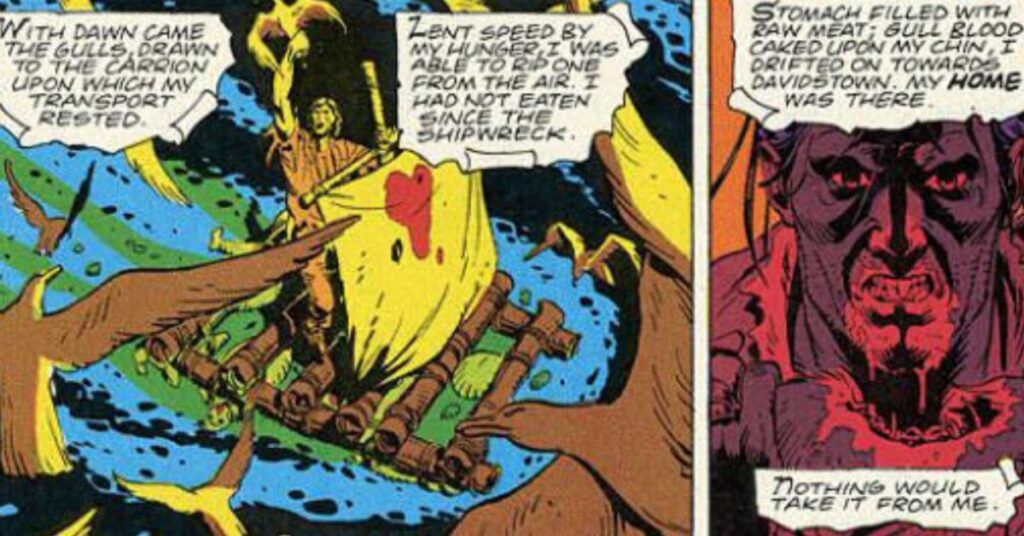
The Watchmen comic book by Alan Moore, Dave Gibbons, and John Higgins is frequently considered the greatest graphic novel of all time by critics and reviewers. Its unique approach to storytelling, complex characters, and exploration of mature themes elevated Watchmen and comics themselves as a medium beyond the realm of stereotypical superhero narratives. Yet, among its many striking features, one aspect that stands out is the use of a comic-within-a-comic narrative — of course, we’re talking about Tales of the Black Freighter.

This Watchmen nestled comic-within-a-comic narrative has puzzled many readers since its publication in the mid-1980s, as it tells a tale of a marooned mariner, his desperate journey home, and the horrific acts he commits along the way. And though the Tales of the Black Freighter narrative might initially seem like an incongruous slice of pulp horror spliced within the larger narrative of Watchmen, upon closer inspection, it reveals itself as a thematic device that ties into the main narrative in many poignant ways, thus offering a stark reflection of the “real” world in Watchmen.
But how do the two actually connect? Well, the denizens of a world in which superheroes are real — and the public opinion of them has soured over time — don’t read comic books about fictitious characters with superhuman abilities since those aren’t actually fictitious within the Watchmen universe. Instead, the comic books in the world of Watchmen mostly revolve around pirates. Through the narrative, we see a young man reading a comic book titled Tales of the Black Freighter, specifically the two-issue story titled “Marooned.”

To understand the connection between the two narratives, we first have to familiarize ourselves with the “Marooned” story, in which a mariner has been stranded on a deserted island after his vessel suffered an attack by the eponymous Black Freighter — which is apparently a pirate ship. As he and all of his crewmates wash ashore, the sailor realizes that he’s the only one to have survived the attack and that all of his crewmates are actually dead. In order to get off the island, he puts together a raft made of his fellow crewmen’s gas-bloated corpses.
As he desperately tries to get home to warn his friends and family about the impending Black Freighter, he has to eat seagulls that fly close by and, in addition, cannibalize bits and pieces of his former crewmen that compose the raft, as well as fight off sharks that were drawn to the “raft.” He even drinks seawater to survive the journey.

The mariner eventually losses his sanity and descends into madness, only to discover that he made it home. Upon reaching his home, which has been taken over by the Black Freighter pirates, he kills the first person he sees — his wife. Overcome with the shock and terror of his actions, the mariner flees and swims out to sea, where the Black Freighter is waiting.
According to Alan Moore, Tales of the Black Freighter is reflective of several different things from the Watchmen narrative, but it’s most closely connected to Ozymandias/Adrian Veidt’s story. The characters of Watchmen are constantly forced to make difficult decisions in the name of the greater good, and the mariner’s journey symbolizes, for the most part, Ozymandias’ character arc. The mariner’s obsessive pursuit of what he sees as the only means to save his home from the Black Freighter parallels Ozymandias’ horrors of being the only one who can save humanity from itself.

Both the mariner and Ozymandias have descended into madness due to the unspeakable horrors they’ve done; the former uses his dead comrades as a raft and kills his wife, and the latter sacrifices his men and subordinates to achieve his ultimate goal. Both are antiheroes forced to do unspeakable deeds to the few for what they believe is for the greater good of the whole. Ozymandias’ plan, though monstrous, was ultimately designed to usher humanity into an enlightened and peaceful age. The potential benefits of this plan were recognized by Dr. Manhattan — portrayed by Yahya Abdul-Mateen II in the TV series.
However, Tales of the Black Freighter isn’t about Ozymandias’ arc alone, as it speaks about the horror and misguided intent that emerge from within each superhero in the Watchmen universe. Just as the mariner is horrified by his own transformation into the monster he wanted to save others from, the superheroes in the Watchmen universe are constantly confronted with the terrifying results of their actions (or inactions, in the case of Dr. Manhattan) regardless of how noble their intentions are.

On top of that, Tales of the Black Freighter breaks up the pacing and tension in the main Watchmen narrative, allowing readers to take a breather before plunging back into the main narrative. Thus, Tales of the Black Freighter is much more than a mere side story; it’s a thematic mirror, a commentary on the horror of good intentions gone awry, and the reflection of the world in which extreme vigilantism exists. The Black Freighter adds yet another layer of complexity to an already dense and literary-allusion-filled series and helps cement its ranking as one of the most important developments in this visual genre.









